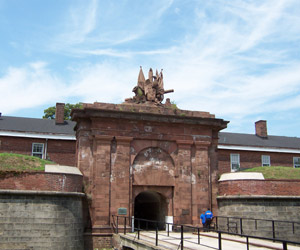- Fort Jay
Infobox Military Structure
name=Fort Jay
Fort Columbus
partof=Governors Island
location=New York, New York
coordinates=
caption=
caption2=
type=Fortification
code=
built=1794, 1806, 1833
builder=Jonathan Williams
materials=Sandstone, Granite, Brick
height=
used=1794-1997
demolished=
condition=Good
ownership=Public - National Park Service
open_to_public=Yes
controlledby=United States of America
garrison=
current_commander=
commanders=
occupants=
battles=
events=Infobox nrhp
name = Fort Jay
nrhp_type = nrhp

caption =
location =Governors Island ,Manhattan ,New York City ,New York
nearest_city =
lat_degrees =
lat_minutes =
lat_seconds =
lat_direction =
long_degrees =
long_minutes =
long_seconds =
long_direction =
area =
built =1808
architect =
architecture =
added =March 27 ,1974
visitation_num = 55,000
visitation_year = 2007
refnum =
mpsub =
governing_body =National Park Service Fort Jay is a harbor fortification and the name of the former Army post located on
Governors Island inNew York Harbor . Fort Jay is the oldest defensive structure on the island built to defendUpper New York Bay , but has served other purposes.The fort is situated on the location of earthworks originally built to defend New York City during the American Revolution. Captured in September 1776, the earthworks served as a British military hospital. In the years following the end of British occupation of New York in 1783, the works fell to ruin. In 1794 they were reconstructed as a square fort with four corner bastions and named after the Federalist New York governor,
John Jay . Again falling into ruin, the fort was upgraded with sandstone and granite and aravelin added between 1806 and 1811. With John Jay's unpopularity in negotiating theJay Treaty with Britain, the fort was renamedFort Columbus until 1904.Construction of the walls and gate of the existing fort were completed in
1808 . Four ranges of brick barracks form a quadrangle inside the walls of the fort and date to1834 , replacing smaller and less substantial wood and brick barracks. The barracks were built as the fortification's ability to protect New York was diminished by the construction ofFort Hamilton andFort Wadsworth at the Narrows of New York Harbor. TheGreek Revival style barracks, unified by two-storey Tuscan porticos first served as officers' and enlisted men's housing for the permanent garrison, then officers' family housing from the 1930s to 1996, when Governors Island was decommissioned. Three 10" and one 15"Rodman cannon s are still in place in the fort, which once had over 50 before the rest were scrapped during World War II in 1942. They date to theAmerican Civil War , and had an accurate range of nearly two miles.The barracks inside the square shaped inner walls of the fort are surrounded by a five-pointed star-shaped walls and a dry moat. The moat is in turn surrounded by a sloped grassy area or
glacis , cleared of trees, that provided no cover for any advancing enemy forces and would have retarded or stopped cannon shot from naval ships. In the nineteenth century, the glacis was used as the post's parade ground and in the twentieth century, the Army and U.S. Coast Guard used the grass surrounding the fort as a polo field and from the mid-1930'=s until 1996 as a golf course (now demolished).The entrance gate was completed in 1801 and is crowned by a sandstone carving of the
United States Department of War insignia.History
The first earthen citadel was constructed on this site starting in April 1776 and eight cannons were mounted there for the defence of New York Harbor. The Americans abandoned the earthworks in August 1776 after George Washington's defeat in the
Battle of Brooklyn and the resulting British occupation of New York. The British Army improved the existing earthworks until they departed in 1783. In 1794, the State of New York began to finance improvements to improve the earthworks, then in ruin. Eleven years later, the first plans for restoring the fort were discussed in Congress and in 1797, an appropriation of $30,117 was made for continued construction. The State of New York conveyedGovernors Island and the works at Fort Jay to the Federal government in February 1800. The earthworks were replaced by granite and brick walls and the footprint of the fort enlarged to designs by Maj. Jonathan Williams, U.S. Army Corps of Engineers and supervisor of fortifications in New York Harbor. The fort's walls and moat were completed in 1808.Fort Jay was originally named for
John Jay , New York governor, Supreme Court Justice, Secretary of State and one of the "founding fathers " of the United States. Jay, as George Washington's Secretary of State negotiated an unpopular, but essential treaty, theJay Treaty , addressing unresolved issues with Great Britain in the years after the Revolutionary War. With the change in presidential administrations and the recent transfer to the federal government, the fort was named Fort Columbus for Christopher Columbus. In 1904, Secretary of War,Elihu Root renamed the army post onGovernors Island that had evolved around the fort to restore the name of the fortification to Fort Jay.The fort is now part of the
Governors Island National Monument , administered by theNational Park Service .External links
* [http://www.nps.gov/gois/ National Park Service website for Governors Island National Monument]
* [http://forgotten-ny.com/STREET%20SCENES/governorsisland2/govisl.html Forgotten NY]
* [http://memory.loc.gov/cgi-bin/query/r?pp/hh:@field(DOCID+@lit(NY0347)) U.S. Library of Congress: American Memory] Images, drawings and data pages
* [http://www.dmna.state.ny.us/forts/fortsE_L/jayFort.htm NY Military History]
* [http://www.correctionhistory.org/civilwar/governorsisland/frame_main1.html Military Prison History]
Wikimedia Foundation. 2010.
